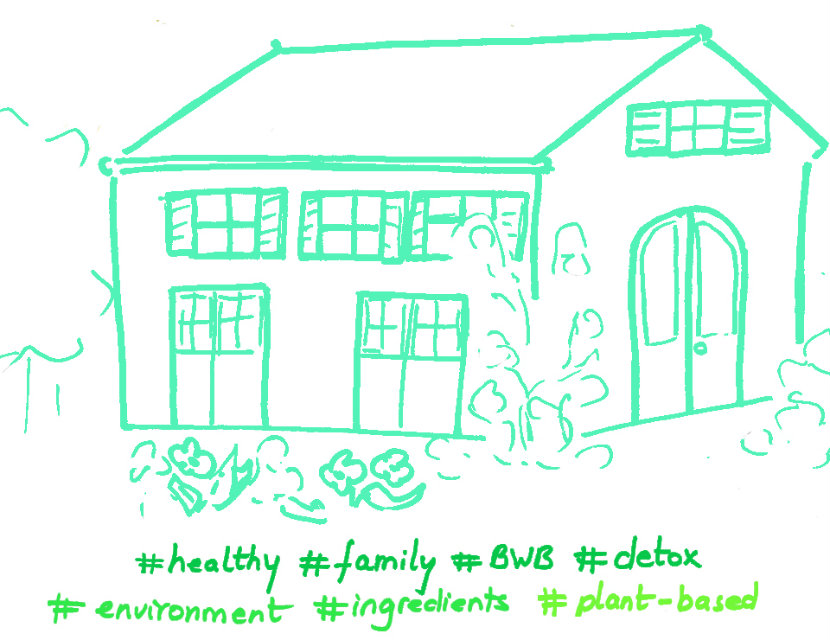Clean Green Home for Kids
It’s important to keep in mind two things when it comes to kids. First, the impact ingredients have on their developing systems. Second, the hidden toxins in the products we use every day.
In this day and age, raising our children in a healthy, safe, kind environment is a minefield of choices and trade-offs. As a chef who has studied nutrition for nearly two decades, I know that food choices play a significant role in health and well-being for kids and adults alike. However, as a writer and researcher who has studied environmental science for the same duration of time, I see that there are many other pieces of the puzzle that are of paramount importance, especially for children. And, as a mother of a 3-1/2 year old boy, I am at the intersection of applying all of this knowledge in a real-time way. What are the things that have the biggest impact on my child? Is plastic ok sometimes or should I always avoid it? If I grew up doing something won’t my child be ok doing it?
It’s important to keep in mind two things when it comes to kids. First, the impact ingredients have on their developing systems. Second, the hidden toxins in the products we use every day.
It’s important to keep in mind two things when it comes to kids. First, the impact ingredients have on their developing systems. Second, the hidden toxins in the products we use every day.
Here are 5 categories of products to help create the healthiest, safest, kindest environment for your children at home.

Laundry Products
Look for an ingredient list you understand & consider fragrance-free detergents.
- Choose clean, green laundry products that are made from plant- and mineral-based ingredients to protect your children’s skin from common synthetic ingredients that are also in the environment.
- Look for an ingredient list you understand.
- Consider fragrance-free detergents. While good-smelling products are appealing, fragrances can cause skin reactions.
- Use less detergent. Using more detergent doesn’t get clothing cleaner.
- Avoid chlorine bleach and chemical stain removers. Chlorine is highly corrosive and can both irritate and be absorbed through skin contact. Plus, vapors from chlorine are dangerous to breathe and are a measurable contributor to indoor air pollution.
- If you like fabric softeners, go with something natural. Conventional fabric softeners are common causes of skin rashes and make clothing more flammable. Dryer sheets can also release fumes when heated up in the dryer that may be dangerous to breathe.
Bath and Skin Care Products
Choosing natural bath and body products for children is a paramount priority.
Skin is our largest organ and upwards of 60% of what is applied to skin reaches the bloodstream. Because of this, choosing natural bath and body products for children is a paramount priority.
Here are some tips to choose and use healthy, clean bath and body products for kids:
The first few ingredients will disclose what the bulk of the product is made from, while last few typically include fragrances, preservatives and colorants easy to overlook.
- Look at ingredient lists, not just the claims on the front of the label, to know exactly what is in the product. Learn how to read an ingredient list: the first few ingredients and the last few ingredients will tell you the most about the products’ formula. The first few ingredients will disclose what the bulk of the product is made from, while last few typically include fragrances, preservatives and colorants easy to overlook.
- Soap, body wash, bubble bath and shampoo (plus anything else that creates suds). Look for products that are free of sodium lauryl sulfate (SLS) and sodium laureth sulfate (SLES), both of which are used as surfactants and have great foaming action but are also linked with health concerns. Both enhance the skin’s absorptive capacity, which is a concern if the product contains other ingredients that you don’t necessarily want delivered more efficiently to the bloodstream. They have also shown to lower skin’s natural immune response, which is one of the body’s first lines of defense in the immune system, and is especially important for the wee ones.
- Moisturizer, lotion and conditioner.
Look for plant-based products with ingredients you can identify. Watch out for Paraben preservatives as their toxicity can disrupt hormones, but also keep an eye out for other synthetic preservatives, as they all deserve equal scrutiny. There is a family of formaldehyde-releasing preservatives that include diazolidinyl urea, imidazolidinyl urea, hydantoins and quaterniums that I suggest to avoid with a 10-foot pole. - Pay attention to fragrances.
Look for products that are fragrance-free or are formulated with natural, plant-based fragrances that are clearly disclosed. Undisclosed fragrances – listed simply as fragrance – are very likely to contain phthalates, a product used to help make fragrances “stick” and are linked to a host of serious health concerns including endocrine disruption, developmental toxicity and disorders.
Minimizing Plastic
Plastic is ubiquitous and difficult to escape in this day and age. Minimizing it, however, is a key part of keeping a healthy, kid-friendly household, especially with regards to new items that are prone to off-gas. Here are some tips to minimize plastic where it counts most and choosing better options whenever possible:
Heat releases the unstable chemicals and additives in plastics, which leads to them seeping into foods or drinks.
- Don’t mix hot foods and plastic.
Putting hot food and drinks in plastic containers is never a good idea. Heat releases the unstable chemicals and additives in plastics, which leads to them seeping into foods or drinks. Note also that fatty foods and plastic are the worst combination of all because many of the chemicals in plastic are more soluble in fat. - Use less plastic cling wrap or choose an alternative.
Although plastic wrap is a mainstay and convenient, most of it is made from the worst kinds of plastics (PVC and its cousins), laden with softening chemicals that can easily migrate into foods. Covering a bowl with plastic wrap is ok if it doesn’t come in contact with the food. - Toss out old, scratched plastic containers.
Scratched plastic releases more unwanted chemicals into foods and drinks than new containers do. While you’re at it, avoid putting plastic in the dishwasher as hot water and detergents break down plastic and increase chemical leeching as well.
Cleaner, Greener Cleaning Products
The combination of a child’s lighter body weight and developing body systems makes the category of cleaning products an essential one to prioritize for a clean, safe environment in your home. Here are some guidelines to choose cleaning products that are eco-smart and human-friendly and what to look for on labels.
Look for these words: Plant-based, Mineral-based, Biodegradable, Chlorine Free, Ammonia Free, Solvent Free, Phosphate Free, No Synthetic Fragrances or Dyes.
- Full disclosure of ingredients.
The same goes for products as for food. If they don’t have a comprehensive list of ingredients, they are always suspect for harboring nasty chemicals. If a product doesn’t have an ingredients list, look for one that does so you know what you are using. - Look for products with labels that explain ingredients.
Look for qualifiers such as “plant-based” surfactants or “natural” fragrances. The more description there is, the better. Nontoxic, eco-friendly products generally boast about their attributes on their labels. - Look for these words:
Plant-based, Mineral-based, Biodegradable, Chlorine Free, Ammonia Free, Solvent Free, Phosphate Free, No Synthetic Fragrances or Dyes to ensure the cleanest, greenest choices for your family and home.
Visit the Environmental Working Group’s Guide to Healthy Cleaning for an interactive database of over 2,000 products with easy-to-navigate safety ratings along with a Label Decoder to translate technical terms and ad hype.
Avoid Non-Stick Chemicals
Non-stick chemicals certainly have a convenient function. However, the chemicals used to make materials non-stick, stain-resistant and fire-retardant are all highly toxic, accumulate and remain in the body for a very long time. They are linked to developmental issues and cancer, and are wickedly persistent in the environment. Here are some tips to reduce and eliminate exposure to non-stick chemicals in your home:
Avoid non-stick cookware in favor of stainless steel, cast iron, enameled cast iron, copper, ceramic, glass and silicone.
- Cookware.
Avoid non-stick cookware in favor of stainless steel, cast iron, enameled cast iron, copper, ceramic, glass and silicone. - Textiles.
Avoid “stain-resistant” textiles including carpets, upholstery, furnishings, bedding and clothing. - Food Packaging.
Avoid microwave popcorn in favor of air-popped or stove-popped popcorn; Avoid fast-food packaging, snack and candy wrappers that are noticeably slick on the interior - Personal Care and Cosmetic Products.
Avoid products that contain fluoro-, perfluoro, or PFTE ingredients, as can be found in some makeup and moisturizers.
So as you’re looking out for your kiddos as they grow, heed some of these tips to give their developing bodies the healthiest home environment possible.

Renée Loux is a chef, author, journalist, educator, entrepreneur, consultant, media personality and mother.
www.reneeloux.com







